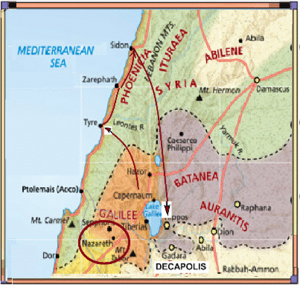Jesus has moved to a primarily Gentile region. While His words appear harsh, He is teaching the disciples and communicating His main purpose to minister to the Jews. He is also testing the lady. Her faith shines through.
Overview
Jesus:
- Travelled a long way
- Had a Long term perspective
- Lingered before responding but healed instantly
- Left a long term impact in the region
The woman:
- Was persistent
- Positive
- On point
Bible Passage
Persistent faith Matt 15:21-28; Mark 7.24-30
Matthew 15:21 Leaving that place, Jesus withdrew to the region of Tyre and Sidon. 22 A Canaanite woman from that vicinity came to him, crying out, “Lord, Son of David, have mercy on me! My daughter is demon-possessed and suffering terribly.”
23 Jesus did not answer a word. So his disciples came to him and urged him, “Send her away, for she keeps crying out after us.”
24 He answered, “I was sent only to the lost sheep of Israel.”
Bible Passage
Matthew 15:25 The woman came and knelt before him. “Lord, help me!” she said.
26 He replied, “It is not right to take the children’s bread and toss it to the dogs.”
27 “Yes it is, Lord,” she said. “Even the dogs eat the crumbs that fall from their master’s table.”
28 Then Jesus said to her, “Woman, you have great faith! Your request is granted.” And her daughter was healed at that moment.
Background
This passage at the outset appears almost as an insult to Gentiles calling them dogs. However the original text does not portray it in that manner. “kuon”,in Greek means “wild cur”, Jews often refer to Gentiles as dogs in this manner. Jesus however, is referring to “kunarion”, meaning “small dog” or “pet dog.”
Background
Background
Jesus is teaching the disciples and communicating His main purpose to minister to the Jews. He is also testing the lady.
Background
In Matthew 7:6 when Jesus referred to “dogs” as “wild cur” or “kuon”, He refers to both Gentiles and Jews who are unresponsive to the gospel.
“Do not give what is holy to the dogs; nor cast your pearls before swine, lest they trample them under their feet, and turn and tear you in pieces” (Matthew 7:6).
Background
Jesus – Travelled a long way
It was around 35 miles from Capernaum to Tyre.
Why did Jesus make this long trip via a Gentile area of Tyre and Sidon?
Tyre, in Jesus’ time
In New Testament times, Tyre was the main seaport of the Roman province of Syria and Phoenicia – a prosperous city with pagan temples and twin harbours built on either side of a small island. The Roman settlement, to the south of the island, was constructed adjacent to the causeway linking it to the mainland, built by Alexander the Great during his seige in 332BC. Tyre became part of the Roman Empire in 64BC and was one of the first Roman cities in the region to embrace Christianity. [1]
Tyre, in Jesus’ time
Jesus – Had a long term perspective
On two occasions in this passage – first to the disciples, then to the Canaanite woman, Jesus stresses that his ministry is for the Jews.
Matthew 15:24 He answered (to the disciples), “I was sent only to the lost sheep of Israel.”
Matthew 15:26 He replied (to the woman), “It is not right to take the children’s bread and toss it to the dogs.”
Jesus – Had a long term perspective
Jesus was communicating that his ministry focus was to the Jews.
While our minds are too small to fathom God’s purposes, my personal thought is that in spite of current hardness, the hastening of the chosen nation’s return to Christ will hasten the return of the rest of the world as well.
Jesus – Lingered before responding but healed instantly
He ignored her
He responded in a way that could have turned her off
Possibly this lingering was to bring out that response of faith that resulted in immediate healing.
To demonstrate this faith to the world.
Jesus – left a long term impact in that region
Tyre and Sidon were Gentile cities north of Israel, Jesus still ministered to them: crowds from Tyre and Sidon came to see and listen to Him (Mark 3:7–8).
For if the miracles that were performed in you had been performed in Tyre and Sidon, they would have repented long ago in sackcloth and ashes. Matthew 11:22 But I tell you, it will be more bearable for Tyre and Sidon on the day of judgment than for you. Luke 10:13.
The woman – was persistent
Matthew 15:23 Jesus did not answer a word. So his disciples came to him and urged him, “Send her away, for she keeps crying out after us.”
Jesus ignored her. The disciples were annoyed. But she kept crying for mercy.
In Luke 18:1-8 Jesus commends the widow who’s persistence got her justice.
Persistent prayer
When we pray regularly for:
- The unsaved
- The unreconciled
- The falling away
In some way or other, the persistence pays off.
God’s Perspective
The woman was positive
She well know the precedence the Jews held in Kingdom matters.
But she also knew that she too can benefit from God’s mercy.
Little did she know that that healing was just about to be poured out to the whole world through Christ’s death.
The woman was on point
She had a perception many Jews didn’t
She knew He was the son of David (Messiah)
She called Him Lord
She sought mercy – which characterized God.
Persistent faith today
In the 21st century how should our faith scale up?
Do we have perception beyond our peers?
Are we able to see things of true value and pursue them with persistence?
Discussion
1.Jesus goes great distances to seek and honour few, sometimes even one true heart of faith. What do we learn?
2.What is the right kind of persistence and wrong kind of persistence for a Christian?
3.What motivates us to remain positive even in negative situations?
References
1. Biblejourney.org




